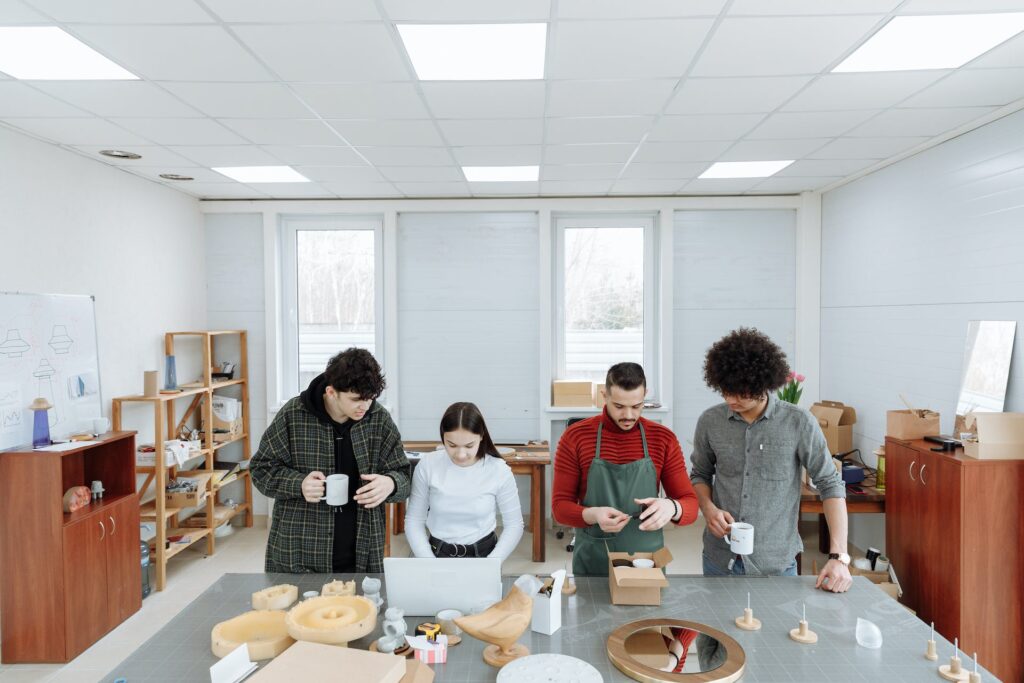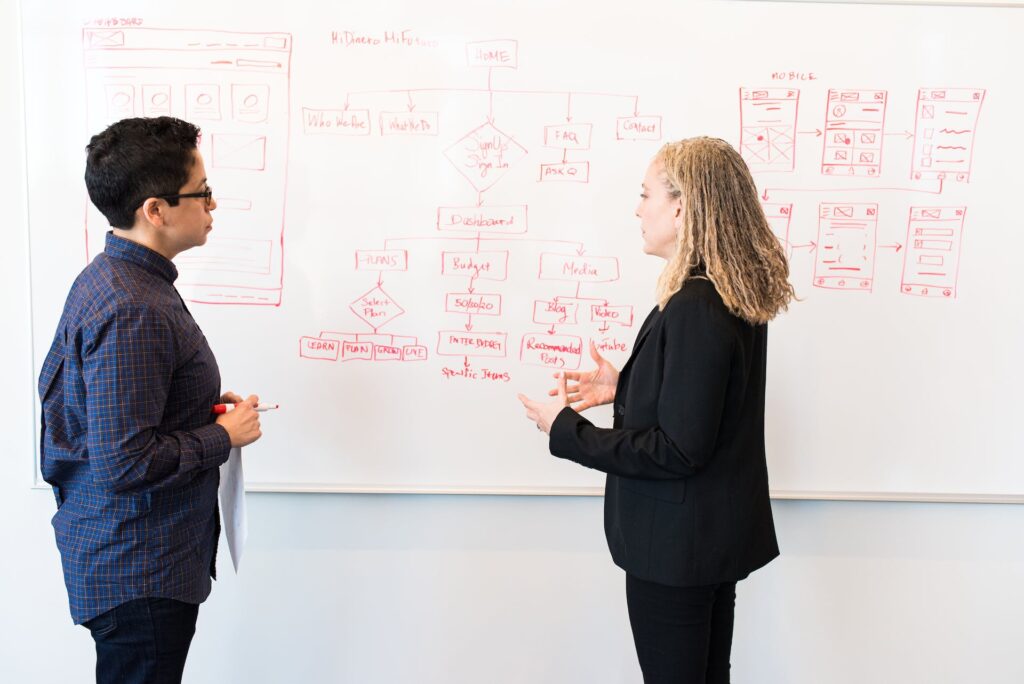When Avalara approached us to redesign their website and optimize their user experience, they faced a common challenge: their product had evolved significantly, but their digital presence hadn’t kept pace. Traditional agency approaches would have meant a six-month project, a big reveal, and then… silence until the next major redesign years later. This mirrors the origins of industrial design, where static, pre-launch projects were the norm—unlike today’s digital product development, which relies on continuous, iterative improvement.
Instead, we implemented continuous product design—an approach that transformed their digital experience through ongoing iteration, data-driven optimization, and relentless focus on user needs. The result? Not just a better website, but a systematic process for continuous improvement that keeps delivering value long after the initial launch.
For CMOs, UX Directors, and Product leaders at B2B software companies, continuous product design isn’t just a methodology—it’s a competitive advantage. Let’s explore how this approach can transform your product development process and drive measurable business outcomes.

Table of Contents
- The Essence of Continuous Product Design
- Core Principles of Continuous Product Design
- Tools and Techniques for Effective Continuous Product Design
- Case Studies: Success Stories of Continuous Product Design
- Implementing Continuous Product Design
- Summary
The Essence of Continuous Product Design

Continuous product design is a strategic approach that B2B software companies use to drive sustainable growth and innovation. Unlike traditional “set it and forget it” product development, this methodology treats your digital products as living systems that evolve based on customer feedback, market demands, and data-driven insights. The design process has shifted from rigid, stage-gated models to a continuous, iterative framework that supports ongoing optimization and adaptation.
In our work with companies like Qualtrics and Cotality, we’ve seen how continuous product design creates alignment across product managers, designers, engineers, and go-to-market teams. Everyone works from the same source of truth: actual user behavior and feedback.
The benefits extend far beyond better products. Organizations implementing continuous product design see:
- Faster time-to-value: Launch MVPs in weeks, not months, then iterate based on real usage
- Higher conversion rates: Our Crolytics.ai platform helps clients identify and fix conversion barriers continuously
- Reduced development waste: Build what users actually need, validated through data
- Improved team alignment: Shared metrics and regular feedback loops keep everyone focused on what matters
Continuous product design also enables teams to address design problems more effectively by allowing for rapid iteration and real-world testing.
Understanding this approach requires examining its three core components: the iterative process for perpetual improvement, systematic customer feedback integration, and adaptive response to market demands.
Download the Summary of the Continuous Product Design: The Complete Guide to Iterative Excellence for B2B SaaS Companies now!
Don't have time to read everything or need a summary of the key points?
Iterative Process for Perpetual Improvement
In continuous product design, iteration isn’t a phase—it’s the operating model. Product teams establish regular cycles of feedback collection, analysis, prioritization, and implementation. This mirrors the continuous discovery habits that leading product teams have adopted, where customer engagement isn’t a one-time research project but an ongoing conversation.
The iterative cycle typically flows through these stages:
- Analysis: Examine current product performance using analytics, user feedback, and conversion data
- Prioritization: Identify high-impact opportunities using frameworks like ICE (Impact, Confidence, Ease) scoring
- Design: Create solutions ranging from quick optimizations to significant feature additions
- Implementation: Deploy changes using agile methodologies that support rapid iteration
- Testing: Validate hypotheses through A/B testing, user testing, and behavioral analysis
- Learning: Document insights and feed them back into the next cycle
At Passionates, our subscription model is specifically designed to support this iterative approach. Whether clients need our Grow tier for design and development, Optimize tier for CRO and UX research, or Innovate tier for AI-powered personalization, they get dedicated senior resources (5+ years experience) who can pivot between tasks as priorities shift—delivering iterations in 1-3 working days rather than weeks.
Leveraging Customer Feedback
Customer feedback is the fuel that powers continuous product design. But collecting feedback isn’t enough—you need systematic processes to analyze it, prioritize it, and act on it. Understanding customer needs is essential during this process, as it ensures that feedback is aligned with what truly matters to your users and drives meaningful product improvements.

For B2B SaaS companies, effective feedback collection combines multiple approaches:
- Quantitative data: Analytics platforms (GA4, Mixpanel, Hotjar) reveal what users actually do
- Qualitative insights: User interviews and session recordings explain why they do it
- Behavioral signals: Conversion funnel analysis identifies where users struggle
- Support data: Customer service interactions highlight recurring pain points
- Usage patterns: Product analytics show which features drive engagement and retention
Our Optimize tier integrates UX research and CRO expertise to help clients build these feedback systems. We’ve helped B2B software companies implement continuous research programs that generate actionable insights weekly, not quarterly.
Consider how this works in practice: A SaaS company notices drop-off in their onboarding flow. Quantitative data shows where users abandon. Qualitative research reveals why—confusing terminology, unclear value proposition, or technical friction. The team prioritizes fixes based on impact, implements changes, and validates results through A/B testing. This cycle repeats continuously, compounding improvements over time.
Adapting to Market Demands
B2B software markets evolve rapidly. New competitors emerge, buyer expectations shift, and technological capabilities expand. Continuous product design enables companies to adapt without the risk and delay of major redesigns.
This adaptability requires:
- Market intelligence: Regular monitoring of competitor offerings, industry trends, and customer sentiment
- Flexible architecture: Technical foundations, built on strong engineering practices, that support rapid feature addition and modification
- Cross-functional agility: Teams empowered to respond to opportunities without bureaucratic delays
- Experimentation culture: Permission to test new approaches and learn from failures quickly
Our clients achieve this agility by combining our subscription-based resources with their internal teams—scaling up for major initiatives, scaling down during maintenance periods, and always maintaining the capability to respond quickly to market changes.
Core Principles of Continuous Product Design

Three fundamental principles underpin successful continuous product design: a customer-centric approach, agile methodologies, and data-driven decision making. These aren’t just buzzwords—they’re operational frameworks that guide daily decisions and long-term strategy. By applying these principles, teams can create products that continuously evolve based on user feedback and market changes, ensuring they meet customer needs effectively.
Customer-Centric Approach: Keeping User Needs Forefront
In continuous product design, customer-centricity means embedding the customer voice into every decision, every sprint, and every design iteration.
For B2B SaaS companies, this presents unique challenges. Your “users” might include end users who interact with your product daily, administrators who configure it, executives who evaluate ROI, and IT teams who handle integration. Each persona has different needs, pain points, and success metrics. Effective continuous product design addresses all of them systematically.
Our work with Maslansky and Partners demonstrates this approach. We didn’t just design for their end clients—we designed for their internal teams who needed to deliver client work efficiently. By understanding the full ecosystem of users, we created solutions that improved both client satisfaction and internal productivity. This comprehensive approach leads to higher customer satisfaction by ensuring products are closely aligned with customer needs.
Successful customer-centric design requires:
- Continuous validation: Testing assumptions with real users before committing significant resources
- Regular user engagement: Weekly or bi-weekly customer conversations, not annual surveys
- Persona-based prioritization: Different user types get appropriate attention based on business impact
- Empathy mapping: Understanding emotional and practical needs, not just functional requirements
Agile Methodologies: Flexibility in Development
Agile methodologies provide the operational framework for continuous product design. They enable teams to work in short iterations, incorporate feedback rapidly, and adapt to changing requirements without derailing projects.
For B2B software companies, agile approaches offer several advantages:
- Reduced risk: Smaller iterations mean smaller potential failures and faster course correction
- Faster feedback loops: See results in weeks, not quarters
- Better resource utilization: Focus effort on validated priorities, not speculative features
- Improved stakeholder communication: Regular demos and updates keep everyone aligned
At Passionates, our subscription model naturally supports agile workflows. Clients submit requests through their preferred project management system (ClickUp, Asana, Slack), we prioritize based on impact and effort, and deliver working solutions in 1-3 days. This rapid cadence enables true continuous product design—not quarterly planning cycles that become outdated before implementation.
Data-Driven Insights: Informed Decision Making
In continuous product design, data transforms opinions into evidence and assumptions into validated hypotheses. Every design decision—from button placement to feature prioritization—should be informed by reliable data about user behavior and business impact. Data analytics and experimentation also enable teams to optimize product features, ensuring that each functionality is refined for better user experiences and improved business outcomes.
Our proprietary Crolytics.ai platform exemplifies this principle. Rather than relying on third-party tools that require extensive configuration and interpretation, we’ve built an AI-powered CRO platform that automatically identifies conversion barriers, prioritizes optimization opportunities, and tracks improvement over time.
Effective data-driven design requires multiple data sources:
- Behavioral Analytics: User flow analysis, heatmaps, session recordings, funnel analysis, and cohort tracking
- Performance Metrics: Page load times, conversion rates across segments, engagement metrics, and business metrics like MRR and customer acquisition cost
- Experimentation Data: A/B test results, multivariate tests, personalization performance, and feature adoption rates
For B2B SaaS companies, the key is connecting product metrics to business outcomes. A design change that improves engagement is good; one that increases trial-to-paid conversion or reduces churn is transformative.
Tools and Techniques for Effective Continuous Product Design

Implementing continuous product design requires the right combination of tools, techniques, and expertise. At Passionates, we’ve built our service tiers specifically to provide B2B software companies with everything they need for successful continuous product design.
User Research for Deeper Understanding
User research in continuous product design isn’t a one-time discovery phase—it’s an ongoing practice that generates fresh insights throughout the product lifecycle.

Our Optimize tier includes dedicated UX researchers who implement systematic research programs combining qualitative methods (user interviews, usability testing, contextual inquiry) with quantitative approaches (surveys, analytics analysis, card sorting).
For B2B SaaS companies, effective research requires understanding the buying committee, not just end users. We help clients research across end users, administrators, security teams, and executives—ensuring the product serves all stakeholders effectively.
By maintaining continuous research programs, our clients never lose touch with evolving user needs. Research insights feed directly into design iterations, creating a closed loop between user feedback and product improvement.
Prototyping and Testing for Immediate Feedback
Prototyping is where ideas become tangible, testable artifacts. In continuous product design, rapid prototyping enables teams to validate concepts before investing in full development—reducing risk and accelerating learning.
Our Grow tier provides senior designers who create prototypes ranging from low-fidelity wireframes to high-fidelity interactive models using tools like Figma, Adobe XD, and Sketch. The fidelity level depends on what you’re testing.
The prototyping process follows a systematic approach: Define what hypothesis you’re testing, create the minimum prototype needed, test with real users, analyze patterns in feedback, and iterate based on insights.
For B2B software companies, prototyping offers particular value in testing complex workflows, validating new features, de-risking redesigns, and creating stakeholder alignment. Our rapid 1-3 day delivery enables true continuous prototyping—not monthly design sprints that slow momentum.
Analytics and A/B Testing for Performance Tuning
Analytics and experimentation transform continuous product design from an art into a science. By measuring user behavior and testing design variations, teams can optimize products based on evidence rather than opinions.
Our team integrates comprehensive analytics across your product using platforms like Google Analytics 4, Mixpanel, Hotjar, and Amplitude. We configure tracking to capture user acquisition sources, onboarding completion rates, feature adoption patterns, conversion events, and technical performance metrics.
Our Optimize tier includes CRO specialists who design and analyze experiments using platforms like Optimizely, VWO, or Google Optimize. For B2B SaaS companies, high-impact testing areas include homepage messaging, pricing page design, signup flows, onboarding sequences, and feature discovery.
Crolytics.ai Advantage: Our proprietary platform goes beyond standard analytics by using AI to automatically identify conversion barriers, prioritize optimization opportunities, generate data-driven hypotheses, track improvement trends, and provide actionable recommendations—not just data.
Case Studies: Success Stories of Continuous Product Design
Real-world examples illustrate how continuous product design drives measurable business outcomes for B2B software companies.
Avalara: User-Centric Innovation
Challenge: Avalara, a leading tax compliance software provider, had evolved their product significantly but their website hadn’t kept pace. Their digital presence didn’t effectively communicate their expanded capabilities or guide prospects through increasingly complex buying journeys.
Approach: Rather than a traditional redesign, we implemented continuous product design. We conducted user interviews with prospects, customers, and internal stakeholders. Deep-dive analytics revealed specific drop-off points. We created and tested multiple design variations for high-impact pages, rolled out improvements incrementally, and established a continuous testing program.
Results: The continuous approach enabled Avalara to launch initial improvements in weeks rather than months, validate design decisions with real user data before full implementation, maintain business continuity without disruptive launches, and build internal capabilities for ongoing optimization.

Qualtrics: Continuous Improvement at Scale
Challenge: Qualtrics needed ongoing design and motion graphics support for their marketing initiatives, but traditional agency relationships created bottlenecks. Long lead times, scope negotiations, and project-based pricing slowed their ability to respond to market opportunities.
Approach: Qualtrics subscribed to our Grow tier, providing dedicated senior design and motion graphics resources with flexible allocation, rapid 1-3 day turnaround, consistent enterprise-grade quality, and scalable capacity.
Results: The subscription model enabled Qualtrics to respond to market opportunities within days, maintain consistent brand quality across all deliverables, eliminate procurement friction and budget unpredictability, and scale creative capacity based on actual needs.
Cotality: Agile Market Response
Challenge: Cotality, an emerging B2B software company, needed to establish their digital presence quickly while maintaining flexibility to adapt as their product and market evolved.
Approach: We implemented continuous product design from day one: launched an MVP website in weeks, gathered user feedback and analytics data immediately, made weekly improvements based on user behavior, quickly adjusted messaging as the competitive landscape evolved, and added capabilities incrementally as the business matured.
Results: The agile approach enabled Cotality to launch a professional digital presence quickly, adapt messaging based on actual market response, add functionality as business needs evolved, and maintain competitive relevance in a fast-moving market.
Implementing Continuous Product Design
Understanding continuous product design is one thing; implementing it successfully is another. Here’s a practical framework for B2B software companies.
Building Internal Capabilities
- Start with Mindset Shift: Move from “projects” to “programs,” embrace experimentation, focus on learning velocity, and measure outcomes rather than outputs.
- Establish Core Practices: Implement weekly user research, regular data reviews, continuous experimentation, and cross-functional collaboration.
- Develop Key Skills: Build capabilities in user research, data analysis, hypothesis testing, agile project management, and stakeholder communication.
Partnering with Passionates
Many B2B software companies find that partnering with specialized agencies accelerates their continuous product design capabilities while building internal competencies.
- Grow Tier ($8,000/month full-time, $5,000/month part-time): Dedicated senior designer/developer resource with 1-3 day turnaround and flexible task allocation—perfect for maintaining continuous improvement cadence.
- Optimize Tier ($10,000/month full-time, $6,000/month part-time): Everything in Grow, plus UX research and CRO expertise, systematic research programs, A/B testing support, and Crolytics.ai platform access—ideal for data-driven continuous optimization.
- Innovate Tier ($12,500/month full-time, $7,250/month part-time): Everything in Optimize, plus AI and automation capabilities, custom AI agent implementation, personalization workflows, and advanced system integration—best for companies pushing the innovation frontier.
Our approach includes systematic knowledge transfer through comprehensive documentation, team training, transparent processes, and strategic guidance on building internal capabilities.
Measuring Success
Continuous product design requires continuous measurement. Track metrics across three categories:
- User Metrics: Task completion rates, time to value, feature adoption, user satisfaction scores (NPS, CSAT), and support ticket volume
- Business Metrics: Conversion rates, customer acquisition cost (CAC), customer lifetime value (LTV), monthly recurring revenue (MRR), and churn rate
- Process Metrics: Iteration velocity, experiment volume, learning rate, and team satisfaction
The key is connecting user improvements to business outcomes—demonstrating that continuous product design isn’t just better UX, it’s better business.
Summary
Continuous product design represents a fundamental shift from periodic redesigns to ongoing optimization. For B2B software companies, this approach offers compelling advantages: faster time-to-value, reduced development waste, higher conversion rates, and better market adaptability.
The core principles—customer-centricity, agile methodologies, and data-driven decision making—provide a framework for implementation. The right tools and techniques—user research, prototyping, analytics, and experimentation—enable execution. Clear roles and strong collaboration ensure sustained success.
Whether you build internal capabilities, partner with specialized agencies like Passionates, or combine both approaches, the key is starting. Begin with small iterations, measure results, and build momentum over time.
The companies that master continuous product design won’t just have better products—they’ll have systematic competitive advantages that compound over time. In fast-moving B2B software markets, that advantage can be decisive.
Ready to implement continuous product design in your organization? Book a consultation to discuss your specific needs and priorities: Schedule a call
Want to see how our subscription model supports continuous design? Explore our Grow, Optimize, and Innovate tiers at passionates.com, and check out these 9 useful tips for website maintenance to keep your site performing at its best.
